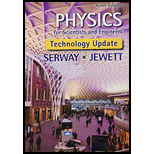
Concept explainers
(a)
The volume of turpentine overflows.
(a)
Answer to Problem 19.21P
The volume of turpentine overflows is
Explanation of Solution
Given info: The initial volume of aluminum cylinder and turpentine is
Formula to calculate the change in volume of aluminum cylinder is,
Here,
Formula to calculate the change in volume of turpentine is,
Here,
The relation between coefficient of volume expansion of aluminum and coefficient of linear expansion of aluminum is,
Here,
The coefficient of linear expansion of aluminum is
Substitute
Thus, the coefficient of volume expansion of aluminum is
Write the expression for the temperature difference,
Substitute
Thus, the temperature difference is
Write the expression for overflow volume of the turpentine,
Substitute
The coefficient of volume expansion of turpentine is
Substitute
Conclusion:
Therefore, the volume of turpentine overflows is
(b)
The volume of turpentine remaining in the cylinder at
(b)
Answer to Problem 19.21P
The volume of turpentine remaining in the cylinder at
Explanation of Solution
Given info: The initial volume of aluminum cylinder and turpentine is
Write the expression for the new volume of turpentine in the cylinder,
The coefficient of volume expansion of turpentine is
Substitute
Conclusion:
Therefore, the volume of turpentine remaining in the cylinder at
(c)
The distance for the cylinder’s rim does the turpentine surface recede.
(c)
Answer to Problem 19.21P
The distance for the cylinder’s rim does the turpentine surface recede is
Explanation of Solution
Given info: The initial volume of aluminum cylinder and turpentine is
Write the expression for the volume of the turpentine in the cylinder after it cools back to
Write the expression for temperature difference,
Here,
Substitute
Thus, the temperature difference is
Substitute
Write the expression for the percentage of cylinder that is empty at
Substitute
The distance for the cylinder’s rim does the turpentine surface recede is,
Conclusion:
Therefore, the distance for the cylinder’s rim does the turpentine surface recede is
Want to see more full solutions like this?
Chapter 19 Solutions
Bundle: Physics for Scientists and Engineers, Technology Update, 9th Loose-leaf Version + WebAssign Printed Access Card, Multi-Term
- pls help on all asked questions kindlyarrow_forward19. Mount Everest, Earth's highest mountain above sea level, has a peak of 8849 m above sea level. Assume that sea level defines the height of Earth's surface. (re = 6.38 × 106 m, ME = 5.98 × 1024 kg, G = 6.67 × 10 -11 Nm²/kg²) a. Calculate the strength of Earth's gravitational field at a point at the peak of Mount Everest. b. What is the ratio of the strength of Earth's gravitational field at a point 644416m below the surface of the Earth to a point at the top of Mount Everest? C. A tourist watching the sunrise on top of Mount Everest observes a satellite orbiting Earth at an altitude 3580 km above his position. Determine the speed of the satellite.arrow_forwardpls help on allarrow_forward
- pls help on allarrow_forward6. As the distance between two charges decreases, the magnitude of the electric potential energy of the two-charge system: a) Always increases b) Always decreases c) Increases if the charges have the same sign, decreases if they have the opposite signs d) Increases if the charges have the opposite sign, decreases if they have the same sign 7. To analyze the motion of an elastic collision between two charged particles we use conservation of & a) Energy, Velocity b) Momentum, Force c) Mass, Momentum d) Energy, Momentum e) Kinetic Energy, Potential Energyarrow_forwardpls help on all asked questions kindlyarrow_forward
- pls help on all asked questions kindlyarrow_forward17. Two charges, one of charge +2.5 × 10-5 C and the other of charge +3.7 × 10-6 C, are 25.0 cm apart. The +2.5 × 10−5 C charge is to the left of the +3.7 × 10−6 C charge. a. Draw a diagram showing the point charges and label a point Y that is 20.0 cm to the left of the +3.7 × 10-6 C charge, on the line connecting the charges. (Field lines do not need to be drawn.) b. Calculate the net electric field at point Y.arrow_forward3arrow_forward
 College PhysicsPhysicsISBN:9781285737027Author:Raymond A. Serway, Chris VuillePublisher:Cengage Learning
College PhysicsPhysicsISBN:9781285737027Author:Raymond A. Serway, Chris VuillePublisher:Cengage Learning Principles of Physics: A Calculus-Based TextPhysicsISBN:9781133104261Author:Raymond A. Serway, John W. JewettPublisher:Cengage Learning
Principles of Physics: A Calculus-Based TextPhysicsISBN:9781133104261Author:Raymond A. Serway, John W. JewettPublisher:Cengage Learning College PhysicsPhysicsISBN:9781305952300Author:Raymond A. Serway, Chris VuillePublisher:Cengage Learning
College PhysicsPhysicsISBN:9781305952300Author:Raymond A. Serway, Chris VuillePublisher:Cengage Learning Physics for Scientists and Engineers: Foundations...PhysicsISBN:9781133939146Author:Katz, Debora M.Publisher:Cengage Learning
Physics for Scientists and Engineers: Foundations...PhysicsISBN:9781133939146Author:Katz, Debora M.Publisher:Cengage Learning
 Physics for Scientists and Engineers with Modern ...PhysicsISBN:9781337553292Author:Raymond A. Serway, John W. JewettPublisher:Cengage Learning
Physics for Scientists and Engineers with Modern ...PhysicsISBN:9781337553292Author:Raymond A. Serway, John W. JewettPublisher:Cengage Learning





